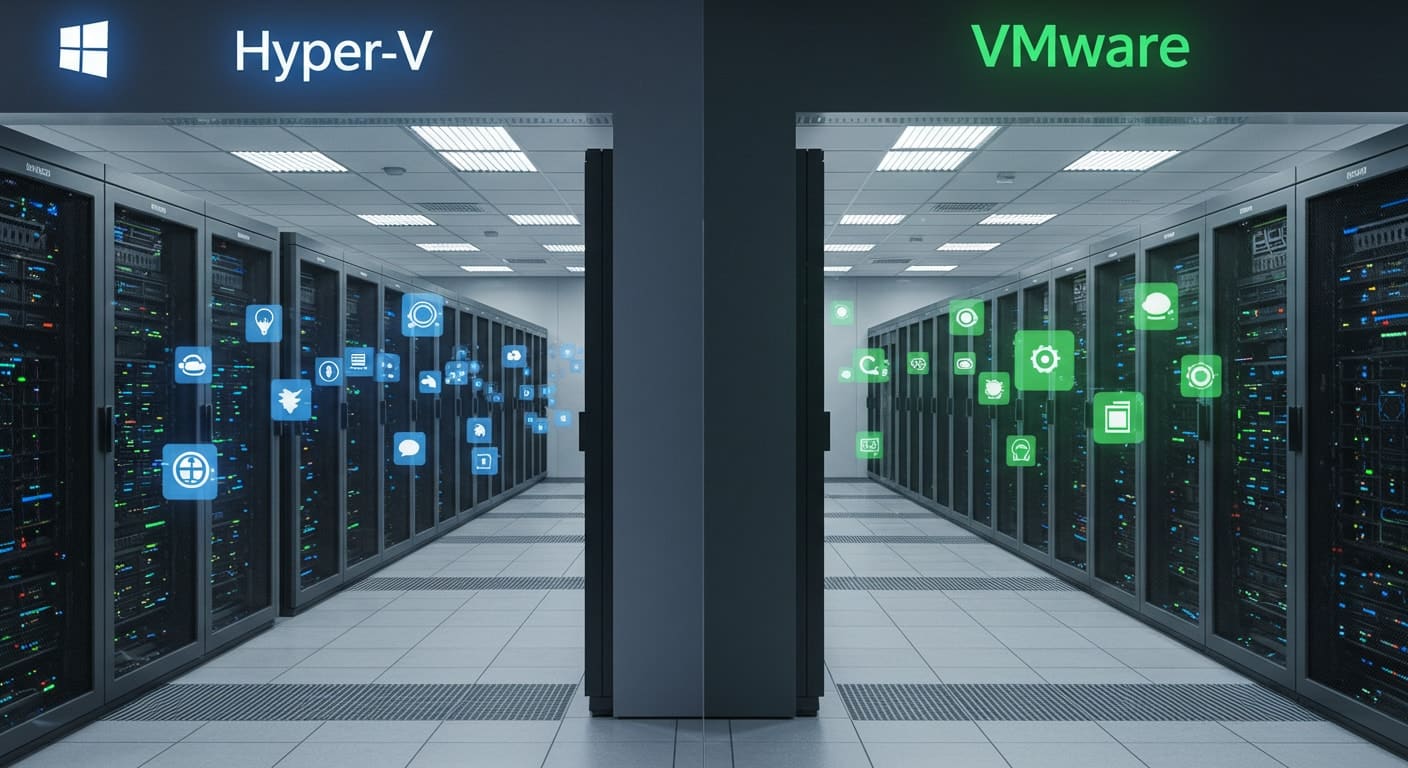Virtualization isn’t a luxury anymore — it’s a foundational layer of modern IT infrastructure. Whether you’re managing a few workloads or a sprawling data center, the ability to run multiple virtual machines on a single host has become essential to efficient operations.
Two names dominate the conversation: Microsoft Hyper-V and VMware vSphere. Both offer robust performance, scalable architecture, and deep integration options — but their approaches differ significantly.
This article breaks down those differences. You’ll explore how each platform handles performance, management, security, operating system support, and cost — so you can confidently decide which virtualization solution best fits your environment.
What Is Microsoft Hyper-V and How Does It Work?

Microsoft Hyper-V is a Type 1 hypervisor that enables you to create and manage virtual machines (VMs) directly on physical hardware, with tight integration into the Windows Server operating system. Designed for both small deployments and large enterprise environments, Hyper-V is built into Windows Server and can also be run as a standalone product through Hyper-V Server.
How does Hyper-V integrate with the Windows ecosystem?
Hyper-V’s biggest advantage lies in its seamless compatibility with the Microsoft stack:
- Bundled with Windows Server: Hyper-V is included with most Windows Server licenses, reducing costs and simplifying deployment in Windows-centric environments.
- Hyper-V Manager: A native management tool that offers a familiar interface for Windows administrators to create, monitor, and control VMs.
- Advanced features: Includes dynamic memory allocation, which optimizes resource utilization across multiple VMs, and nested virtualization, allowing virtual machines to run other VMs inside them — useful for test labs or training.
If you’re already invested in Windows infrastructure, Hyper-V often feels like an extension rather than an add-on.
What Is VMware vSphere and How Is It Structured?
VMware vSphere is a virtualization platform suite built around VMware ESXi, a bare-metal hypervisor known for high performance and reliability. It’s a popular choice in enterprise environments requiring scalability, multi-OS support, and advanced virtualization features.
What are the core components of VMware’s virtualization platform?
VMware uses a layered, modular approach:
- VMware ESXi: A hypervisor that installs directly on hardware, managing virtual machines without a host OS.
- vCenter Server: Centralized management for all ESXi hosts and VMs, enabling clustering, automation, and templates.
- vSphere: The complete platform for resource optimization, high availability, and role-based access — built to support complex, virtualized environments.
In hybrid or large-scale deployments, vSphere’s flexibility, integration capabilities, and enterprise-grade tooling make it a go-to choice.
Which Platform Offers Better Integration with Windows Environments?
When working in Windows-centric environments, Hyper-V has a clear edge. Built by Microsoft and bundled with Windows Server, it integrates tightly with the OS and broader Microsoft ecosystem.
How does Hyper-V support Windows workloads?
- Licensing: Included in most Windows Server editions, reducing overhead
- Optimization: Tuned for Windows virtual machines
- Security: Native support for Shielded VMs and Secure Boot
Does VMware support Windows efficiently?
Yes — but without the same native alignment:
- OS compatibility: Broad, including Windows VMs
- Licensing: Separate from the OS, adding costs in Windows environments
If your infrastructure is Microsoft-heavy, Hyper-V is typically more seamless and budget-friendly.
How Do Hyper-V and VMware Compare on Core Features and Performance?

Both Hyper-V and VMware offer essential virtualization features: support for mission-critical workloads, dynamic memory allocation, and reliable uptime. But VMware delivers deeper automation and enterprise polish.
What features enhance performance and uptime?
- Live migration is available on both, though VMware’s vMotion handles larger clusters more gracefully.
- Nested virtualization and dynamic memory are supported on both platforms.
- VMware vSphere HA and DRS provide built-in failover and resource optimization, giving VMware a performance edge.
How do storage and data protection compare?
- VMware offers vSAN, encryption, and policy-based provisioning.
- Hyper-V supports Storage Spaces Direct, BitLocker, and Secure Boot.
- Both enable snapshots, shared storage, and flexible VM migration, but VMware’s storage integration is more granular at scale.
What’s the Difference in Management Experience Between the Two Platforms?
Day-to-day management is where some platforms shine or fall short. Both Hyper-V and VMware offer strong tools, but the experience varies depending on environment size and administrator background.
Which platform is easier for administrators to manage?
If you’re working within a Windows environment, Hyper-V tends to feel more familiar:
- Hyper-V Manager is simple, lightweight, and tightly integrated with Windows.
- Great for single-host setups or small clusters without complex dependencies.
VMware, on the other hand, delivers more advanced control:
- vCenter Server offers centralized dashboards across clusters, hosts, and virtual machines.
- VMware Tools adds deep visibility into guest operating systems and performance metrics.
What about third-party and Microsoft tools?
- Hyper-V integrates smoothly with tools like System Center Virtual Machine Manager (SCVMM) and PowerShell.
- VMware connects with a wide range of third-party plugins and automation suites like Ansible, Puppet, and vRealize.
Admins who want straightforward management may prefer Hyper-V. For complex or large-scale environments, VMware’s extensibility and control can be hard to match.
Which Platform Scales Better in Enterprise and Cloud Environments?

Scalability isn’t just about running more VMs — it’s about how efficiently a platform adapts to growth, cloud integration, and fluctuating workloads.
How well do Hyper-V and VMware scale?
Both platforms scale effectively, but their strengths lie in different areas:
- Hyper-V scales smoothly within Microsoft’s Azure ecosystem. If you’re using Azure Stack HCI or looking to extend your infrastructure to the Microsoft cloud, Hyper-V aligns well with native tools and policies.
- VMware shines in multi-cloud and hybrid deployments. Its Cloud Foundation suite supports seamless workload movement between on-prem, AWS, Azure, and other cloud providers.
What are the differences in resource utilization?
- VMware offers advanced tools like Distributed Resource Scheduler (DRS) and network virtualization for intelligent workload balancing.
- Hyper-V provides dynamic memory, virtual networking, and centralized bandwidth management through System Center.
In high-scale or multi-site deployments, VMware’s automation and optimization tools often provide a more granular edge.
How Do Security Features Compare Between Hyper-V and VMware?
Security is critical for any virtualization platform, and both Hyper-V and VMware deliver strong, built-in protections.
What built-in security features are available?
- Secure Boot ensures only signed OS files run at startup.
- Role-Based Access Control (RBAC) restricts user actions across virtual environments.
- Hyper-V supports BitLocker and Shielded VMs, while VMware vSphere includes native VM Encryption.
How do both platforms protect virtual networks and data?
- Hyper-V offers virtual switch isolation, spoofing protection, and port ACLs.
- VMware NSX adds micro-segmentation, virtual firewalls, and centralized policy controls.
For highly regulated industries, VMware provides deeper network security layers. Hyper-V, however, offers comprehensive protection for Windows-centric environments with less complexity.
Which Platform Supports a Wider Range of Operating Systems and Virtual Workloads?

Compatibility plays a big role when selecting a virtualization platform — especially if your workloads go beyond just Windows.
Can you run multiple OS types on both platforms?
Yes. Both platforms offer broad support:
- Hyper-V: Windows Server, Windows 10/11, select Linux distributions (Ubuntu, CentOS, Debian)
- VMware: Supports a wider range including Windows, Linux, BSD, and some legacy systems
- Nested virtualization: Available on both, allowing you to run VMs inside VMs — useful for test environments and DevOps workflows
- Container support: More robust in VMware via integrations like Tanzu (Kubernetes)
Which workloads are better suited to each platform?
- Hyper-V is ideal for Windows-first environments, especially those relying on Microsoft Active Directory, SQL Server, or Exchange.
- VMware excels in mixed workloads, especially in large, complex infrastructures requiring automation, resilience, and OS diversity.
What Are the Cost and Licensing Considerations for Hyper-V vs VMware?
Cost and licensing models can be deal-breakers for some teams — and this is an area where Hyper-V often leads on simplicity.
How does licensing differ between the two?
- Hyper-V is bundled with many editions of Windows Server, meaning you can start virtualizing without any extra hypervisor costs.
- VMware, however, requires separate licensing — typically per processor socket or host — and features like HA, DRS, and vCenter often come as part of premium bundles.
Which platform is more cost-effective at scale?
- Hyper-V is budget-friendly out of the box, especially for SMBs already invested in the Microsoft ecosystem.
- VMware becomes more costly as your infrastructure scales, but offers deeper enterprise features and long-term support.
| Feature | Hyper-V | VMware |
|---|---|---|
| Included with OS | ✅ | ❌ |
| Subscription Required | ❌ (optional) | ✅ |
| Enterprise Add-ons | Basic | Advanced |
If cost is a primary factor, Hyper-V often wins. For large enterprises with demanding workloads, VMware’s value is in its breadth of functionality.
What Use Cases Are Best Suited for Each Virtualization Platform?

Choosing between Hyper-V and VMware depends on your priorities — cost-efficiency, scalability, OS compatibility, or advanced features.
Where does Hyper-V shine?
Hyper-V is ideal for:
- Windows-centric environments already using Windows Server
- Microsoft administrators familiar with the Hyper-V Manager
- Budget-conscious organizations, as it’s bundled with many Windows Server editions
It’s a strong fit for SMBs and educational institutions with lean IT teams.
Where does VMware excel?
VMware suits:
- Enterprise deployments with complex clusters and networking
- Hybrid or multi-cloud strategies needing flexibility
- Teams requiring vSphere HA, DRS, and NSX integration
If your focus is scale, uptime, and feature-rich virtualization, VMware delivers.
Looking for a Simpler Way to Deliver Virtual Desktops? Try Apporto

If managing Hyper-V or VMware feels like too much overhead — or you simply want a virtualization solution that just works — consider Apporto.
Apporto is a fully managed, browser-based virtual desktop platform. There’s no infrastructure to maintain, no software to install, and no hardware requirements. You get:
- Zero Trust security baked in
- High performance, even over moderate connections
- Simple, cross-platform access from any device
Apporto is ideal for SMBs, educational institutions, and remote-first teams looking to cut complexity without sacrificing capability. Try Apporto now
Final Thoughts: Should You Choose Hyper-V or VMware?
Both Hyper-V and VMware are powerful virtualization platforms, but they serve different priorities.
- Choose Hyper-V if you’re invested in the Microsoft ecosystem, want a cost-effective solution, and prefer straightforward deployment.
- Choose VMware for large-scale, diverse environments that need enterprise-grade features, cross-platform support, and cloud flexibility.
Still undecided? Run a pilot or consider a hybrid setup. If managing infrastructure isn’t your goal, Apporto offers a fully managed, browser-based alternative.
Ultimately, the best platform aligns with your workload, IT resources, and long-term strategy.
Frequently Asked Questions (FAQs)
1. Is Hyper-V free with Windows Server?
Yes. It’s included with most Windows Server editions, offering a cost-effective virtualization platform.
2. Does VMware support Microsoft’s Azure Cloud?
Yes. VMware Cloud on Azure enables cloud extension, though Hyper-V integrates more natively with Azure environments.
3. Which platform performs better under high load?
VMware generally scales better with tools like DRS. Hyper-V holds up well, especially with dynamic memory.
4. Can I run Linux or macOS on Hyper-V or VMware?
Both support Linux. VMware supports more OS types; Hyper-V is optimized for Windows workloads.
5. What’s the best platform for Windows-centric environments?
Hyper-V. It’s built into Windows Server, supports Shielded VMs, and simplifies licensing.


